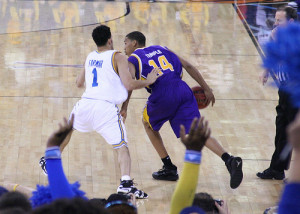3 Ways to Improve a Team’s Defence of the On-Ball Screen

The On-Ball Screen is one of the most widely used tactics for gain an offensive advantage in the modern game of basketball. In Europe, the on-ball screen is used on the perimeter to create long range shooting opportunities, while in North and South America the on-ball screen is utilised to create driving lanes and miss-matches. No matter the desired effect, defending the on-ball screen must be worked at relentlessly to try to extinguish any offensive advantage.
There are a number of different problems which are commonly seen in how team’s attempt to defend an on-ball screen. Some of these come down to correcting technique and others will be about looking at how the offense is using an on-ball screen and trying to take away the most desired option from this strategy and so force other secondary options to be taken.
Communication
As with all things on defence, the first place to often start is with the team’s communication. Screen the screener actions as well as sprinting to screen have become very commonplace in the build up to setting an on-ball screen. Both of these scenarios (as well as an on-ball screen normally) require the defender guarding the screener to communicate, early, clearly and with purpose.
It is suggested that when the screen defender sees the set-up for the on-ball screen that they communicate that there is a screen occurring and to what side it is of the on-ball defender. For example, a defender matched up against an offensive player setting an on-ball screen to the left of the on-ball defender would call “Screen Left, Screen Left”. Repeating the call helps ensure the message is received and the purpose of the communication is understood.
Feel for the Screen
Another useful tactic to help in defending the on-ball screen is for the on-ball defender to extend their arm closest to the screen so they feel where the screen is before the desired contact of the screener is made. For obvious reasons (like causing an offensive foul) the on-ball defender cannot push the screen, but by feeling where the screen is they should be able to gain some additional space within which to adjust their movement and reduce the effectiveness of the screen.
This tactic in some cases will cause the screener to move or adjust to try to create further advantage. This of course then sees the offensive player moving and this heightens the risk of a moving screen being called on the offense.
Define a Strategy
When defending an on-ball screen there are a few different strategies from which to choose. These are going over the screen, under the screen, switching and doubling. There are different variations within each for these, but these four options form the basis for the majority of the common defensive strategies. As a team there needs to be an agreed tactic chosen and utilised by everyone. Having one player not on the same page while on the court can result in very easy scoring opportunities for the opposition.
Just because one strategy is selected initially does not mean that others cannot be employed throughout the game in adjusting to what the offense is doing. This adjustment though requires a team to be well drill in all variations of how the team is likely to defend the on-ball screen.
Another option to vary the defensive strategy is to change how the on-ball screen is defended depending on the amount of time on the shot clock. This can be very effective in testing which tactic is working or just changing the rhythm by which the offense must play the two-man game.
Defending the on-ball screen is a mandatory element of the game of basket. Most teams utilise the on-ball screen within their offense at least in some capacity. So needing to deal with this issue is a non-negotiable. Taking a few moments to implement the options discussed above can make a real difference and help limit the offensive production of a team’s opposition.







